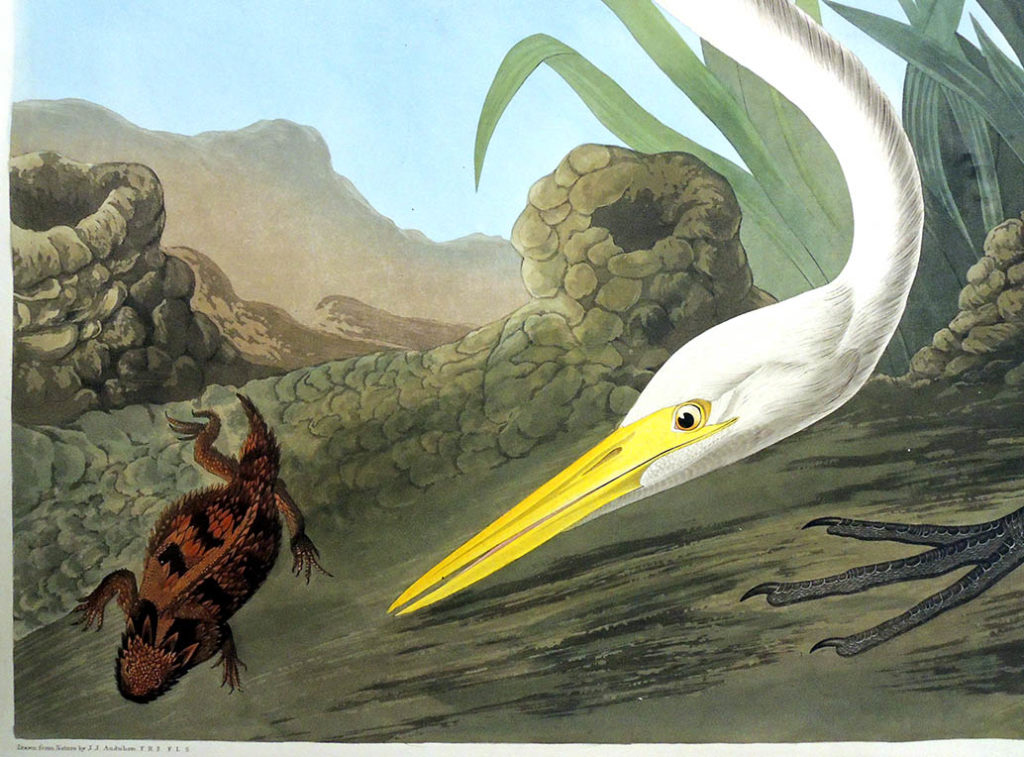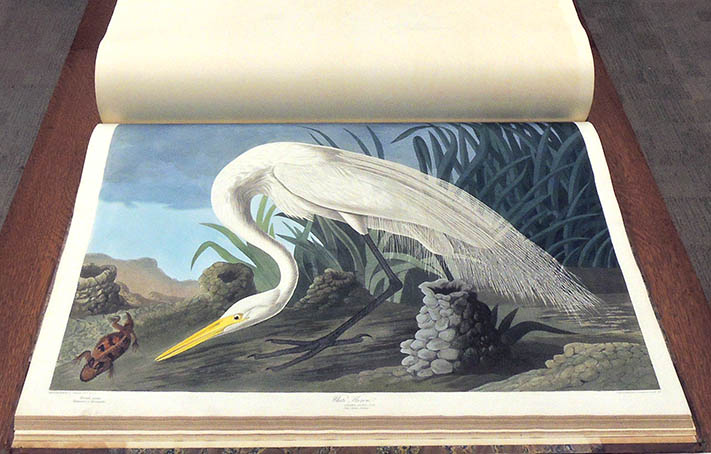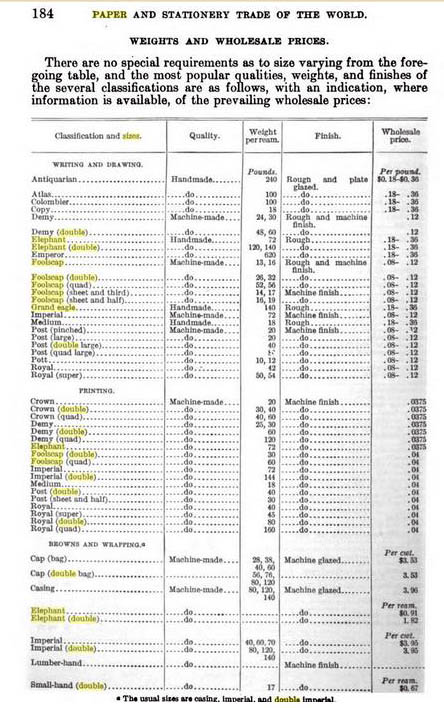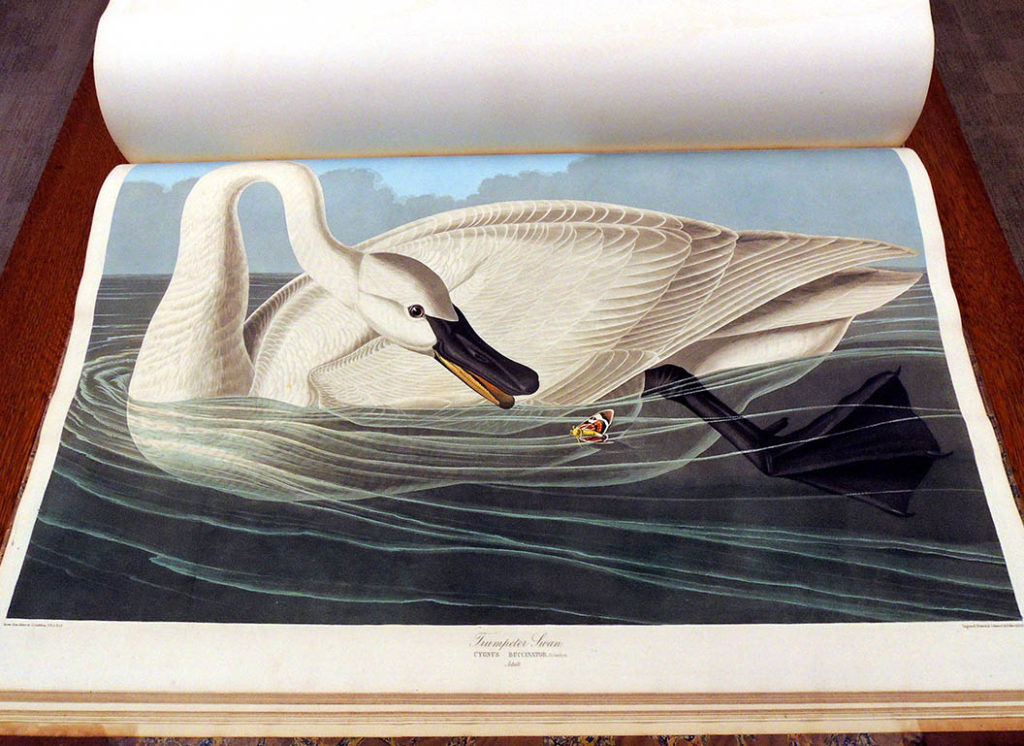 Size is relative. John James Audubon (1785-1851) liked to include insects and other small animals to put the size of his birds in context, such as this White Heron and red lizard.
Size is relative. John James Audubon (1785-1851) liked to include insects and other small animals to put the size of his birds in context, such as this White Heron and red lizard.
 It is often written that Audubon used the largest paper available for his Birds of America but in fact, the “double elephant” was only one of several Imperial size papers made at that time.
It is often written that Audubon used the largest paper available for his Birds of America but in fact, the “double elephant” was only one of several Imperial size papers made at that time.
Below this plate from Birds is compared to a plate from the Description de l’Égypte and suddenly, it’s not quite so big.
It is a tragedy that libraries only measure and record the binding size, with no regard to the paper size (except for a note that the edges have been trimmed). Prints and drawings curators, on the other hand, measure the plate mark, the sheet, and the support (meaning a binding, a mat, or a frame). While many collections around the world regard both Birds and Description as “Double Elephant,” in fact the atlas of Description is closer to the “Grand Eagle” size.
Here are two of the many charts delineating paper sizes:
https://paper-size.com/c/imperial-sizes.html
By the way: While both Birds and Description were created in the early 19th century, both were acquired by Princeton in the early 20th century:
Description de l’Égypte, ou, Recueil des observations et des recherches qui ont été faites en Égypte pendant l’expédition de l’armée française, publié par les ordres de Sa Majesté l’empereur Napoléon le Grand (Paris: Imprimerie impériale, 1809-22). 8 v. in 9: 41 cm; and atlas of 14 v. (73-110 cm.). Rare Books Oversize EX 1821.358e. The Princeton copy is “… the deluxe printing. Penciled in the margins of several of the astronomical line drawings is the name, comte de Pourtalès. …[I}n 1865 [this copy] was sold. Together with other works on Egypt and the ancient Near East, the set was presented to Princeton University in 1921 by the sons of Ralph E. Prime, Jr., of the Class of 1888, after the latter’s death. He had inherited it from a great-uncle, William Cowper Prime (1824-1905), of the Class of 1843. It was evidently he who acquired [this copy] at the Pourtalès sale or soon afterwards.”– Charles C. Gillispie, Monuments of Egypt (1987), p. 42.
John James Audubon (1785-1851), The Birds of America: from original drawings by John James Audubon ... (London: Pub. by the author, 1827-38). 4 v. CCCCXXXV col. pl. 100 cm. Rare Books Oversize EX 8880.134.11e. The Princeton copy “was presented … in 1927 by Alexander van Rensselaer (Princeton, class of 1871), a charter trustee of the University. It had formerly belonged to Stephen van Rensselaer (Princeton, class of 1808) of Albany, New York, one of the original subscribers to the work. The latter’s name appears as no. 32 in Audubon’s list of subscribers.” — Howard C. Rice, An Aububon Anthology, page 16.
This Swan feeds principally by partially immersing the body and extending the neck under water, in the manner of fresh-water Ducks and some species of Geese, when the feet are often seen working in the air, as if to aid in preserving the balance. Often however it resorts to the land, and then picks at the herbage, not sidewise, as Geese do, but more in the manner of Ducks and poultry. Its food consists of roots of different vegetables, leaves, seeds, various aquatic insects, land snails, small reptiles and quadrupeds. The flesh of a cygnet is pretty good eating, but that of an old bird is dry and tough.






